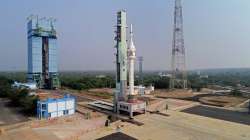Gaganyaan mission: ISRO commences countdown for launch of uncrewed test flight
Gaganyaan mission: ISRO Chairman S Somanath said that the first test vehicle flight will be conducted on October 21. After that we have planned for three more test missions, D2, D3, D4. We will hold thorough tests during the test flight sequence.

Gaganyaan mission: The Indian Space Research Organisation (ISRO) today (October 20) said the countdown for the launch of an uncrewed flight test, marching towards the ambitious mission of sending Indian astronauts into space, finally commenced on Friday.
A single-stage liquid propulsion rocket, equipped with a Crew Module and Crew Escape System, is slated for a lift-off from the first launch pad at the spaceport in Sriharikota at 8:00 am on Saturday (October 21). The test vehicle mission is aimed at studying the safety of the crew module and crew escape system in bringing Indian astronauts back to Earth in the eventual Gaganyaan mission.
What is the motive of Gaganyaan mission?
The Gaganyaan mission aims to send humans into space on a Low Earth Orbit of 400km for a three-day mission and bring them safely back to earth in 2025. On Saturday, ISRO would attempt a successful launch of its Test Vehicle - Demonstration (TV-D1), the single stage liquid propulsion rocket.
The test vehicle mission with this crew module is a significant milestone for the overall Gaganyaan programme as a nearly complete system is integrated for the test tomorrow.
Final countdown begins:
"TV-D1- Test Flight. The countdown leading to the launch at 08:00hrs IST on October 21, has commenced at 7:00 pm" ISRO said on its website on Friday.
The success of this test flight would set the stage for the remaining qualification tests and uncrewed missions, leading to the first Gaganyaan programme, ISRO said. The crew module and the crew escape system are the payloads in the rocket. The crew module is a habitable space with an Earth-like environment in space for the crew. It consists of a pressurised metallic 'inner structure' and an unpressurised 'external structure' with 'thermal protection systems'.
In the first test flight on Saturday, the crew module would capture flight data for evaluation of the performance of various systems onboard, enabling the scientists to gain knowledge on the performance of the vehicle.
The entire test flight sequence on Saturday is expected to be brief as the Test Vehicle Abort Mission (TV-D1) will launch the crew escape system and crew module at an altitude of 17 km which are expected to make a safe touchdown in the sea, about 10 km from Sriharikota on India's eastern coast.
They would later be retrieved by the Navy from the Bay of Bengal. Through this campaign, scientists aim to ensure the safety of the crew who would actually be sent in the crew module on an LVM-3 rocket during the Gaganyaan mission.
(With agencies inputs)
ALSO READ: Gaganyaan's first test flight on October 21: Check when and where to watch LIVE
ALSO READ: Indian Air Force shares video of astronauts set to be part of Gaganyaan mission | WATCH